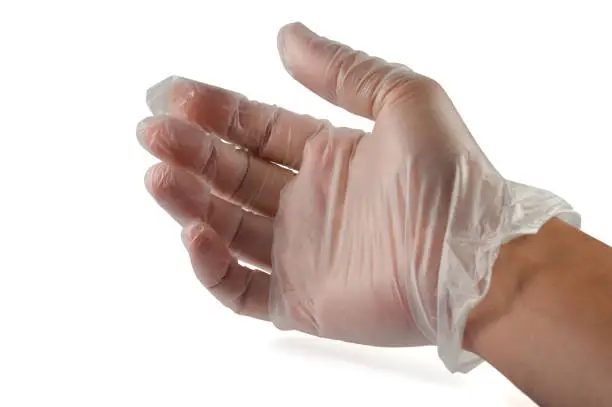In the world of personal protective equipment (PPE), glove thickness is a critical factor that directly impacts protection level, dexterity, and comfort. Whether you’re in healthcare, food processing, manufacturing, or laboratory settings, understanding how to select the appropriate glove thickness can significantly enhance both safety and productivity. This comprehensive guide explores the importance of glove thickness, industry standards, and how to make the right selection for various applications.

## Understanding Glove Thickness Measurements
### Mil vs. Gauge vs. Millimeters
Glove thickness is typically measured in one of three units, which can sometimes cause confusion when comparing products:
**Mil**: The most common measurement in North America, one mil equals one-thousandth of an inch (0.001 inches). For context, a standard sheet of paper is approximately 10 mil thick.
**Gauge**: Primarily used for latex gloves, particularly in medical settings. The gauge system can be confusing as it works inversely—higher gauge numbers indicate thinner gloves. For example, a 9-gauge glove is thicker than a 12-gauge glove.
**Millimeters (mm)**: The metric measurement used internationally, with 1 mil equaling approximately 0.0254 mm. This measurement is becoming increasingly common in global specifications.
### Conversion Chart
For easy reference, here’s a conversion between these common measurements:
| Mil | Millimeters (mm) | Approximate Gauge Equivalent |
|—–|——————|——————————|
| 2 | 0.05 | 17-18 |
| 3 | 0.08 | 15-16 |
| 4 | 0.10 | 13-14 |
| 5 | 0.13 | 11-12 |
| 6 | 0.15 | 10 |
| 8 | 0.20 | 8 |
| 10 | 0.25 | 6 |
| 12 | 0.30 | 5 |
| 14 | 0.36 | 4 |

## Standard Thickness Categories
Most disposable gloves fall into three general thickness categories:
### Lightweight (2-4 mil)
**Characteristics:**
– Highest tactile sensitivity and dexterity
– Less durability and puncture resistance
– Shorter wear time
– Minimal hand fatigue
**Typical Applications:**
– Precision assembly work
– Detailed medical examinations
– Food handling and preparation
– Beauty and salon services
– Light cleaning tasks
### Medium Weight (5-8 mil)
**Characteristics:**
– Good balance between protection and dexterity
– Moderate durability and puncture resistance
– Extended wear time
– Reasonable comfort for longer periods
**Typical Applications:**
– General medical procedures
– Laboratory work
– Food processing
– Light industrial tasks
– Janitorial services
### Heavy Weight (9-15+ mil)
**Characteristics:**
– Maximum protection and durability
– High puncture and chemical resistance
– Longest wear time
– Reduced tactile sensitivity
– Potential for increased hand fatigue
**Typical Applications:**
– Chemical handling
– Heavy industrial work
– Hazardous material cleanup
– Automotive work
– High-risk medical procedures
## Industry-Specific Thickness Requirements
### Healthcare and Medical
In healthcare settings, glove thickness requirements vary based on the specific procedure and risk level:
**Examination Gloves (2-4 mil):**
– Used for routine patient examinations
– Prioritize tactile sensitivity for accurate assessments
– Typically single-use for infection control
– Available in latex, nitrile, and vinyl materials
**Surgical Gloves (5-8 mil):**
– Used during surgical procedures
– Balance protection with the dexterity needed for precise movements
– Often feature textured fingertips for improved grip
– Primarily available in latex and nitrile materials
**High-Risk Procedure Gloves (8-10+ mil):**
– Used in emergency departments, infectious disease units, or when handling chemotherapy drugs
– Prioritize barrier protection over dexterity
– May be used as a second layer (double-gloving) for critical procedures
– Predominantly made from nitrile for chemical resistance
### Food Processing and Service
Food industry glove thickness requirements balance food safety with worker efficiency:
**Food Preparation (2-4 mil):**
– Used for direct food handling and preparation
– Thin enough to maintain dexterity for detailed work
– Changed frequently to maintain hygiene
– Often vinyl or nitrile to avoid latex allergen concerns
**Food Processing (5-8 mil):**
– Used in industrial food processing environments
– Provide protection from minor cuts and abrasions
– Balance protection with the dexterity needed for production line work
– Typically nitrile or polyethylene for durability and food safety
**Meat and Seafood Processing (8-12 mil):**
– Used in environments with higher cut and puncture risks
– Provide enhanced protection from sharp bones, shells, and tools
– May include cut-resistant properties
– Often nitrile or specialized cut-resistant materials
### Industrial and Manufacturing
Industrial applications typically require thicker gloves to protect against various hazards:
**Light Assembly (3-5 mil):**
– Used for electronics assembly and other precision work
– Provide basic protection while maintaining necessary dexterity
– Often feature textured fingertips for improved grip on small parts
– Typically nitrile for oil and grease resistance
**General Manufacturing (6-10 mil):**
– Used in general factory environments
– Provide moderate protection against abrasions and chemicals
– Balance protection with usability for extended periods
– Predominantly nitrile for chemical and puncture resistance
**Heavy Industrial (12-15+ mil):**
– Used in automotive, chemical manufacturing, and heavy machinery environments
– Prioritize maximum protection against chemicals, cuts, and punctures
– May sacrifice some dexterity for enhanced protection
– Often specialized nitrile formulations with additional chemical resistance
### Laboratory and Research
Laboratory environments require gloves that protect against various chemicals while maintaining precision:
**General Laboratory (3-5 mil):**
– Used for routine laboratory procedures
– Provide basic chemical splash protection
– Maintain dexterity for handling delicate equipment and samples
– Typically nitrile for broad chemical resistance
**Chemical Handling (8-12 mil):**
– Used when working with hazardous chemicals
– Provide enhanced chemical permeation resistance
– May be specific to certain chemical classes (acids, bases, solvents)
– Predominantly nitrile or specialized chemical-resistant materials
**Cleanroom Environments (2-4 mil):**
– Used in pharmaceutical, microelectronics, and other cleanroom settings
– Low particulate generation and static properties
– Maintain high dexterity for precision work
– Often specialized nitrile formulations with controlled manufacturing
## Factors Influencing Thickness Selection
### Risk Assessment
When selecting glove thickness, a thorough risk assessment should consider:
**Hazard Type:**
– Chemical: Consider concentration, contact time, and specific chemical properties
– Biological: Evaluate pathogen type and potential exposure routes
– Mechanical: Assess cut, puncture, and abrasion risks
– Thermal: Consider temperature extremes if applicable
**Duration of Use:**
– Short-term tasks may allow thinner gloves for improved dexterity
– Extended wear requires thicker gloves for durability and sustained protection
– Consider fatigue factors for tasks lasting several hours
**Environment:**
– Temperature and humidity can affect glove performance and comfort
– High-stress environments may require more durable options
– Consider if gloves will be exposed to UV light or ozone
### Dexterity Requirements
The level of precision required for a task significantly impacts thickness selection:
**High Precision Tasks:**
– Microsurgery, electronics assembly, laboratory pipetting
– Require thinner gloves (2-4 mil) for maximum tactile sensitivity
– May accept reduced protection for necessary dexterity
**Moderate Precision Tasks:**
– General medical procedures, food preparation, light assembly
– Benefit from medium thickness (5-8 mil) balancing protection and dexterity
– Allow reasonable tactile feedback while providing adequate protection
**Low Precision Tasks:**
– Chemical handling, waste management, heavy industrial work
– Can utilize thicker gloves (9-15+ mil) prioritizing protection
– Dexterity less critical than barrier properties
### Comfort and Ergonomics
User comfort significantly impacts compliance and productivity:
**Hand Fatigue:**
– Thicker gloves require more hand strength to manipulate
– Extended use of thick gloves can lead to increased fatigue
– Consider task duration when selecting thickness
**Fit Considerations:**
– Thicker gloves may require sizing up for comfortable fit
– Material elasticity varies with thickness
– Proper sizing becomes more critical as thickness increases
**Temperature Regulation:**
– Thicker gloves provide more insulation, which can be beneficial or problematic
– Consider workplace temperature and physical exertion level
– Moisture buildup inside gloves increases with thickness
## Material-Specific Thickness Considerations
### Nitrile Gloves
Nitrile gloves offer excellent puncture resistance and chemical protection:
**Thin Nitrile (2-4 mil):**
– Provides tactile sensitivity comparable to latex
– Offers better puncture resistance than latex or vinyl of similar thickness
– Suitable for precision work requiring chemical resistance
– Common in medical examinations and laboratory settings
**Medium Nitrile (5-8 mil):**
– Balances protection with reasonable dexterity
– Provides excellent chemical resistance for most applications
– Offers good durability for extended wear
– Popular in industrial applications and chemical handling
**Heavy Nitrile (9-15+ mil):**
– Provides maximum protection against chemicals and punctures
– Significantly more durable than other materials
– Suitable for high-risk environments
– Common in automotive, manufacturing, and hazardous material handling
### Latex Gloves
Natural rubber latex gloves offer superior elasticity and comfort:
**Thin Latex (2-4 mil):**
– Provides exceptional tactile sensitivity and dexterity
– Offers excellent elasticity and comfort
– Less puncture-resistant than nitrile of similar thickness
– Common in medical examinations and surgical procedures
**Medium Latex (5-8 mil):**
– Maintains good dexterity while improving protection
– Provides excellent elasticity for comfortable fit
– Offers moderate chemical resistance (though poor against oils and solvents)
– Popular in medical and dental applications
**Heavy Latex (9-15+ mil):**
– Provides enhanced protection while maintaining some elasticity
– Less common than heavy nitrile due to chemical resistance limitations
– Offers good grip properties even at higher thicknesses
– Used in specific industrial applications where chemical compatibility allows
### Vinyl Gloves
Vinyl (PVC) gloves are typically the most economical option:
**Thin Vinyl (2-3 mil):**
– Provides basic barrier protection for low-risk environments
– Offers limited durability and puncture resistance
– Minimal chemical protection capabilities
– Common in food service and brief, low-risk tasks
**Medium Vinyl (4-6 mil):**
– Improves durability while maintaining economy
– Provides moderate protection for low-risk environments
– Still limited in chemical resistance compared to nitrile or latex
– Popular in food processing and janitorial services
**Heavy Vinyl (7-10 mil):**
– Less common due to performance limitations compared to nitrile
– Provides improved durability for specific applications
– Still not recommended for chemical handling
– Used in specialized industrial applications where cost is a primary factor
## Regulatory Standards and Compliance
### Medical Glove Standards
Medical gloves must meet specific regulatory requirements:
**FDA Classification:**
– Examination gloves: Class I medical devices (510(k) exempt)
– Surgical gloves: Class I medical devices (510(k) required)
– Specific thickness requirements vary by intended use
**ASTM Standards:**
– ASTM D3578: Specification for rubber examination gloves
– ASTM D6319: Specification for nitrile examination gloves
– ASTM D5250: Specification for poly(vinyl chloride) gloves
– These standards include minimum thickness requirements and performance testing
### Industrial Glove Standards
Industrial gloves follow different regulatory frameworks:
**EN 374 (Europe):**
– Classifies chemical and microorganism protection levels
– Includes permeation testing at specific thicknesses
– Provides pictograms indicating protection levels
**ANSI/ISEA 105 (US):**
– Standardizes performance for various protection properties
– Includes cut resistance, puncture resistance, and chemical permeation
– Testing protocols account for glove thickness
## Best Practices for Selection
### Application-Based Selection Guide
To simplify the selection process, consider these general guidelines:
**Low Risk, High Dexterity (2-4 mil):**
– Basic examinations
– Food preparation
– Electronics assembly
– Laboratory analysis
– Beauty services
**Moderate Risk, Balanced Performance (5-8 mil):**
– General medical procedures
– Food processing
– Light industrial work
– Laboratory chemical handling
– Cleaning and janitorial work
**High Risk, Maximum Protection (9-15+ mil):**
– Chemical manufacturing
– Automotive work
– Hazardous waste handling
– Emergency response
– Heavy industrial applications
### Double-Gloving Considerations
In some high-risk environments, double-gloving provides enhanced protection:
**Recommended Combinations:**
– Inner glove: Thinner (3-4 mil) for dexterity
– Outer glove: Thicker (6-8 mil) for protection
– Different colors aid in breach detection
**Application Examples:**
– Surgical procedures with high fluid exposure
– Handling highly toxic chemicals
– Emergency medical services
– Infectious disease management
### Cost-Benefit Analysis
When evaluating thickness options, consider the total cost of ownership:
**Direct Costs:**
– Thicker gloves typically cost more per unit
– Volume pricing can offset some cost differences
– Material choice often impacts cost more than thickness
**Indirect Costs:**
– Thinner gloves may require more frequent changes
– Breached protection can result in significant incident costs
– Worker productivity impacts from improper thickness selection
– Waste disposal costs for used gloves
## Conclusion
Selecting the appropriate glove thickness is a critical decision that balances protection, dexterity, comfort, and cost. By understanding the specific requirements of your application, the properties of different materials at various thicknesses, and relevant regulatory standards, you can make informed choices that optimize both safety and productivity.
Remember that glove thickness is just one component of a comprehensive hand protection program. Material selection, proper sizing, correct donning and doffing procedures, and appropriate disposal all contribute to effective protection. Regular assessment of glove performance in your specific application ensures that your selection continues to meet your evolving needs.
By taking a systematic approach to glove thickness selection, you can ensure that workers receive appropriate protection while maintaining the dexterity and comfort needed to perform their tasks effectively and safely.



